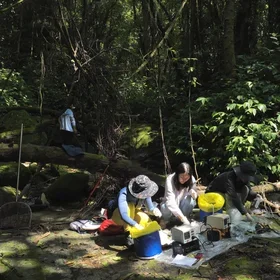By Nick Schiff
Vision. It’s an essential, sometimes elusive element sought among executives. How do you develop it? And how do you effectively communicate it across an organization with nearly 80,000 employees and $15 billion in annual revenue?
These are among Craig Cuyar’s responsibilities as the Global Chief Information Officer at Omnicom Group, a Fortune 200 marketing communications company. He leads the implementation of all technology for the global conglomerate and "drives innovation to expand its client-focused capabilities."
Cuyar dove into these questions with us, granting a rare inside look at his leadership style. He also told us why he loves going to his second job at night—teaching Operations Management in IT as Lecturer in Columbia University’s Technology Management Master’s program.
Walk us through your career path.
I actually started my career as a high school physics teacher. Through serendipity, being in the right place the right time, and having the right background, I ended up moving into an IT leadership role when I was 24. I've been a CIO now for 26 years.
I’ve been a CIO in multiple industries, most of them global roles, all on the professional services side: healthcare, advertising, residential and commercial real estate, private companies, public companies, medium-sized companies, large companies. And now I'm back for another stint in the advertising industry.
This year I've been nominated and ultimately will be inducted in August into the CIO Hall of Fame.
What do you enjoy about being a CIO?
In my role as CIO I get to be creative. There's no one way of doing things.
Compare what I do to the airline industry. For an airline, every single minute is regulated. It doesn't matter whether I get on a United airplane in Amsterdam, like I did on Saturday or get on a United airplane in San Francisco, like I did two weeks ago: I know exactly what the flight attendant is going to say when I get on the plane, when I'm on the plane, and when I get off the plane. To me, that's kind of boring.
In my job, technology is always changing, so I’m constantly analyzing new tech and figuring out how to apply it. I also get to work with people, with the politics and culture of an organization in order to drive revenue and, ultimately, net income from all of these capabilities. That's exciting.
Give us an example of a time when you had to deviate from standard procedure and find a creative solution.
I'll tell you about a highlight in my career from when I was in the residential real estate industry.
At any given time, my company had a million listings in the U.S. across all of our different brands: Coldwell Banker, Century 21, Sotheby's, and we were tasked with driving views to them. We were frustrated that people had to go to each individual site to see what was on the market. Our first idea was to add to our portfolio of listing and aggregate all of them.
But something stood in our way: we had to go to every single Multiple Listing Service in the U.S. in order to do that. At that time, there were over 500 of them. We began a painstaking, time-consuming, expensive process, individually negotiating contracts and paying fees in order to add their listings to ours. It was almost impossible.
We had a realization: we already had 25% of the listings on the US markets through our own brands. Right then, we made a huge pivot. We compiled what we already had and syndicated them like crazy: Coldwell Banker listings now showed up on the 21st Century site, the 21st Century listings showed up on Sotheby's. We also syndicated all of those to Zillow and Google, which were just upstarts at the time. We made the listing itself a commodity and flooded the market.
That virtually eliminated the value of the MLSs. To this day they are struggling. That all happened because years back we realized in real-time that going to individual sites and relying on an MLS was not the wave of the future.
We're now living in a world where companies are flooded with data. How does Omnicom act on its data?
We are actually Google's largest customer in the world. We spend about $3.5-4 billion per year for their data. We use it to target our ads, and from there we build models and algorithms.
But in order to be useful, data has to be timely and relevant, it has to be high-quality, and it has to be ethically obtained. Only from there can we make decisions, day in and day out, about different technologies and different ways of applying them.
At Omnicom we’re using that high quality data to drive machine learning, looking closely at how artificial intelligence can enable programmatic ad placement.
Then we examine those models and algorithms very closely to see if they're producing the results we want.
What does "ethically obtained" mean to you?
It’s funny, this conversation comes up all the time in class.
A couple of years ago we were talking about the Cambridge Analytica scandal. Someone brought up their Facebook photos. I said, "Do you realize you don't own any of those photos once you post them? How often do you actually you read the user license agreement and terms of use when you download that app?" I asked for a show of hands. All I got were a few chuckles.
That means Facebook can do what they want with those photos. They can alter them, they can use them in advertising. We went back and forth for a long time about whether that was right.
Do you have ethical principles you use to navigate these questions?
I do. First, you always want to validate the source of the data. I want to understand how that data was obtained.
Second, do I have a need for that data? A key tenant of the GDPR regulations in Europe is that you can only use the data if you have a legitimate purpose. I can't just acquire a data set of all National IDs in the UK because I want to. But If I'm going to use them, say, in concert with the UK National Health Service to target prescription drug products, then I have a legitimate purpose or need.
If there's information I don't need, that's not relevant, and I can't determine its source, I'll look elsewhere.
What does a typical day look like for you as Global CIO?
I spend most of my time meeting with people, both internal colleagues and external clients, determining the right level of symbiosis—whether relationships fit our business needs. Are they going to help us create the right client or consumer experience? I'm seeing if partners can assimilate to and execute challenges.
How does your daily work translate into what you do in the classroom?
It's really not very different. As a teacher, it's about reading my audience and figuring out what the right questions and challenges are for my students. How do I drive engagement with them?
I model that for my students, and then I ask them to do the same thing. We have a challenge we need to address. Now they need to figure out how to respond, how to create the right conversation which will lead to a consensus which will lead to effective action. That’s how students learn.
What do you think the Technology Management master’s program does well?
It provides so much experience from practitioner faculty.
Many of us faculty members are either current or former IT leaders. What I find, and what I know the students find immensely valuable, is being able to say, "Okay, fine, we've read this book, or we've read this article. I know it says to do A then B then C. But here's how things get done in the real world."
Let's say, for example, our students are tasked with a project, just as they would be in the real world, and the documentation says, “Here's how you're going to design this particular application. It's an agile development model with x, y, and z business requirements."
We teach them that yes, you can create the product that matches your instructions perfectly, with perfect code. But what happens when you've done that in an organization where political undercurrents won't allow it to progress? Or where leadership is not fully supportive of the outcome that's expected? How do you navigate that?
We also talk about one of the key tenets in terms of transformational IT leadership: being able to articulate vision and strategy. Sure, you'll benefit from reading the textbook about vision and strategy. Sure, you can read the company's internal documentation about strategy. But in the program we talk about what happens when the strategy hasn't been properly communicated or propagated across the organization.
I'm shocked by how many students raise their hands and tell me about their organization where the strategy hasn't been articulated, or, even it has been articulated, it hasn't been communicated broadly. So from a real-world IT perspective, how do you align technology efforts to business strategy when the business strategy isn't fully defined or understood?
How do you develop vision? How do you know if someone has it?
In order to develop vision you have to remain acutely aware of what’s happening in the business dynamics around you. That means maintaining a sense of both your traditional and non-traditional competitors and where they are investing.
In my case, I have to be aware of the capabilities of established and up-and-coming technology providers and think about how they’re going to impact my strategy. For example, Omnicom is Google’s largest customer on earth. We spend billions of dollars with them every year. But I need to look at their increasing capabilities with data and AI and determine if they will use them to outcompete us. If so, what is our strategy to handle that?
I can tell pretty quickly if someone has vision. I look at the way they interact with others and by the way they talk about their business. Do they want to implement technology for technology’s sake or are they asking the real questions: How do we apply technology to gain a competitive edge? How could our competition impact or disrupt our business operations going forward?
So you can’t develop vision by doing the same job day in, day out. You have to get out there and see what others are doing. You also have to be well-read and knowledgeable in order to evaluate, prepare for, and respond to oncoming developments.
Let’s say you’ve taught a student how to develop vision for their field successfully. Now they want to go back to their organization and implement it. What tips would you give them?
First, you have to identify where there’s receptivity. Not everyone is going to be enamored or engaged and want to have a conversation around vision. Who’s the right audience, and how do you communicate to that audience?
What inspires you to teach?
A few things. I love helping people learn. In my full-time gig I'm constantly educating people about leveraging new technology to provide business value. My adjunct gig is really just an extension of that, educating people about technology, operations, and ethics.
Teaching also gives me the opportunity to stay current. I get to have conversations about AI, machine learning, ethics, all of these subjects with my students who work at places like Google. My job is to draw out that experience so everyone can benefit.
And I want to give back to my profession. I'm not going to be a global CIO forever. I want to look back in my rearview mirror and say, "Here are people who I’ve helped, whose careers I've influenced, who I've helped gain upward mobility in their organization." That's what I'm going to be proud of.
Do you have any key pieces of advice for aspiring technology executives?
Do what you know is right.
It's not always the easiest path to traverse, but it’s always the best one.
Learn more about the Master of Science in Technology Management program at Columbia’s School of Professional Studies.


